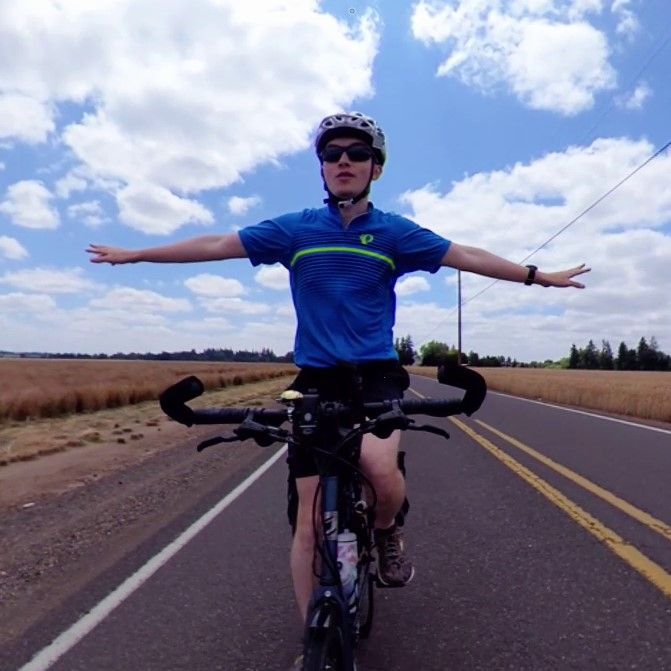Edge Detection and Drawing
This post will serve as a walkthrough of a couple of edge detection methods and an outline of an implementation in Javascript (see demo).
Basics
Consider an image $m$ pixels high by \(n\) pixels wide. For our purposes, we will map the image to grayscale values in the range [0, 255] and represent this data as a matrix $M$. Now let's consider how to do a relatively simple operation such as blurring the image. Intuitively, blurring a pixel means smearing its neighbors on top of it; mathematically this amounts to taking a weighted average of the pixel and its neighbors. This leads us to the idea of a two-dimensional discrete matrix convolution, a form of mathematical convolution where two functions are combined to produce a third function.
The matrix convolution process takes an input matrix and a kernel matrix and produces an output matrix that applies the kernel to each entry in the input by computing a weighted sum (where weights are defined by the kernel) of the entry's neighborhood as the new value for the entry in the output matrix. For example, to blur an image, we may apply convolution with the kernel
$\frac{1}{9}\begin{bmatrix}
1 & 1 & 1 \\
1 & 1 & 1 \\
1 & 1 & 1
\end{bmatrix}$.
This kernel will map each entry to the average of its immediate neighbors, effectively blurring the image, a method called a box blur. We normalize the kernel by dividing by 9 to make sure that the output has the same relative magnitude as the input (i.e. the picture does not become brighter or darker).
Here we delve into the details behind the process. Consider following along with a sample image.
Sobel Operator
The star of the show in this section is the Sobel operator, which is defined as a pair of convolution kernels that estimate the image's horizontal and vertical gradients. The kernel for horizontal gradient, $G_x$ is defined
$\begin{bmatrix}
-1 & 0 & 1 \\
-2 & 0 & 2 \\
-1 & 0 & 1
\end{bmatrix}$.
Note that the entries on the left side are negative, and the entries on the right are positive, so when we apply this operator to an entry, we are finding the difference between its left and right neighborhood, which is the definition of the horizontal gradient. Of course, this approach is only an approximation: we are attempting to construct a continuous gradient of a discrete function (the pixel values). We construct an analogous matrix $G_y$ to estimate the vertical gradient.
Now we apply matrix convolution to $M$ with both $G_x$ and $G_y$ to produce $C_x$ and $C_y$. Since we have gradient values in the horizontal and vertical direction, we can find the overall direction of the gradient at each point. We encode these directions as angles, and we compute $G_{ij} = \arctan\frac{C_{y_{ij}}}{C_{x_{ij}}}$, so each entry in $G$ is the angle of the gradient in radians. By adding together the absolute values of $C_x$ and $C_y$ we arrive at $C$, a matrix that holds the magnitude of the gradient at each point. We return these $G$ and $C$ as the results of applying the Sobel operator.
Nonmaximum suppression
If we only apply the Sobel operator, we may find that the edges are not very fine; we would prefer our edges to be as precise as possible. Nonmaximum suppression is a technique to thin edges by suppressing pixels which are not maximal on the edge gradient. Recall the direction of the gradient $G$ produced by the Sobel operator corresponds to the direction of greatest change in pixel value. Remark that this fact implies that it is directed across edges, and that therefore the actual edge direction should be orthogonal to the gradient's orientation.
Armed with this observation, we find it simple to explain the process of nonmaximum suppression. We visit each entry and decide whether its magnitude is greater than its two neighbors in the direction of the gradient. If not, we suppress the entry by setting its value to 0. Because the entry has only eight neighbors, we can interpolate between neighbors in the gradient direction to obtain a more precise comparison. Now let $S$ be the suppressed matrix.
Hysteresis
What follows is a procedure called hysteresis
where the results are refined by only allowing what we consider ''real'' edges and suppressing the rest. As input, the hysteresis function takes an image matrix and two threshold values $h$ and $l$, both in the range [0, 255], where $h$ is consider the high threshold and $l$ is the low threshold. Supplied with these inputs, hysteresis visits every pixel and decides whether
to keep it based on a couple of criteria:
- If the value of the pixel is greater than $h$, then it is real and we keep it.
- If the value of the pixel is greater than $l$ and it is connected to a
real pixel along a path of pixels where each has value greater than $l$,
then we mark it as real and keep it.
To implement these criteria we can iterate over the matrix, and at each pixel greater than $h$, we perform a recursive search along all neighbors greater than $l$, marking all visited pixels as real along the way. At the end of traversal, we have our set of real pixels and can suppress the rest to obtain the final output.
Canny method
Well, this section will be brief. The Canny method simply applies these steps in order.
- Gaussian blur
- Sobel operator
- Nonmaximum suppression
- Hysteresis
On the demo page, the Automate process button executes precisely this process.

View Comments